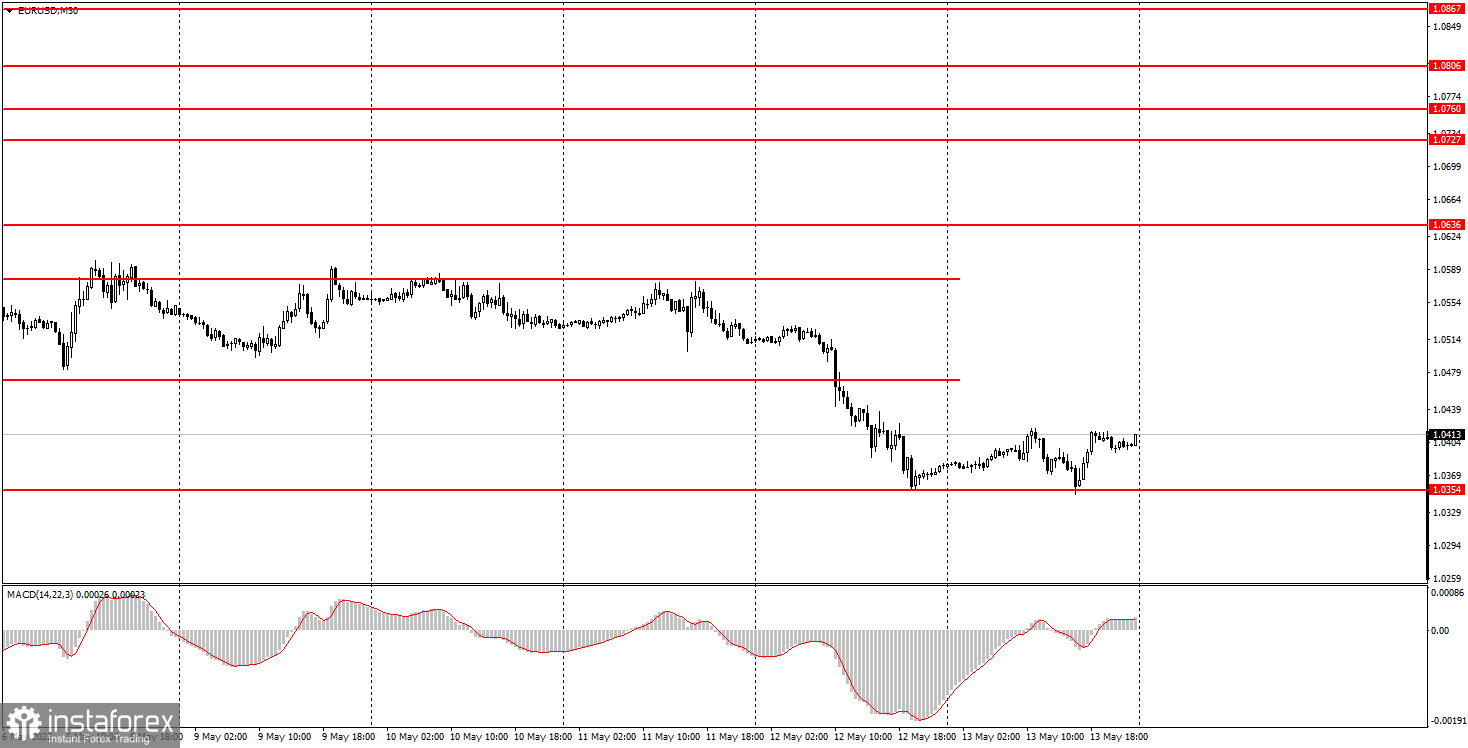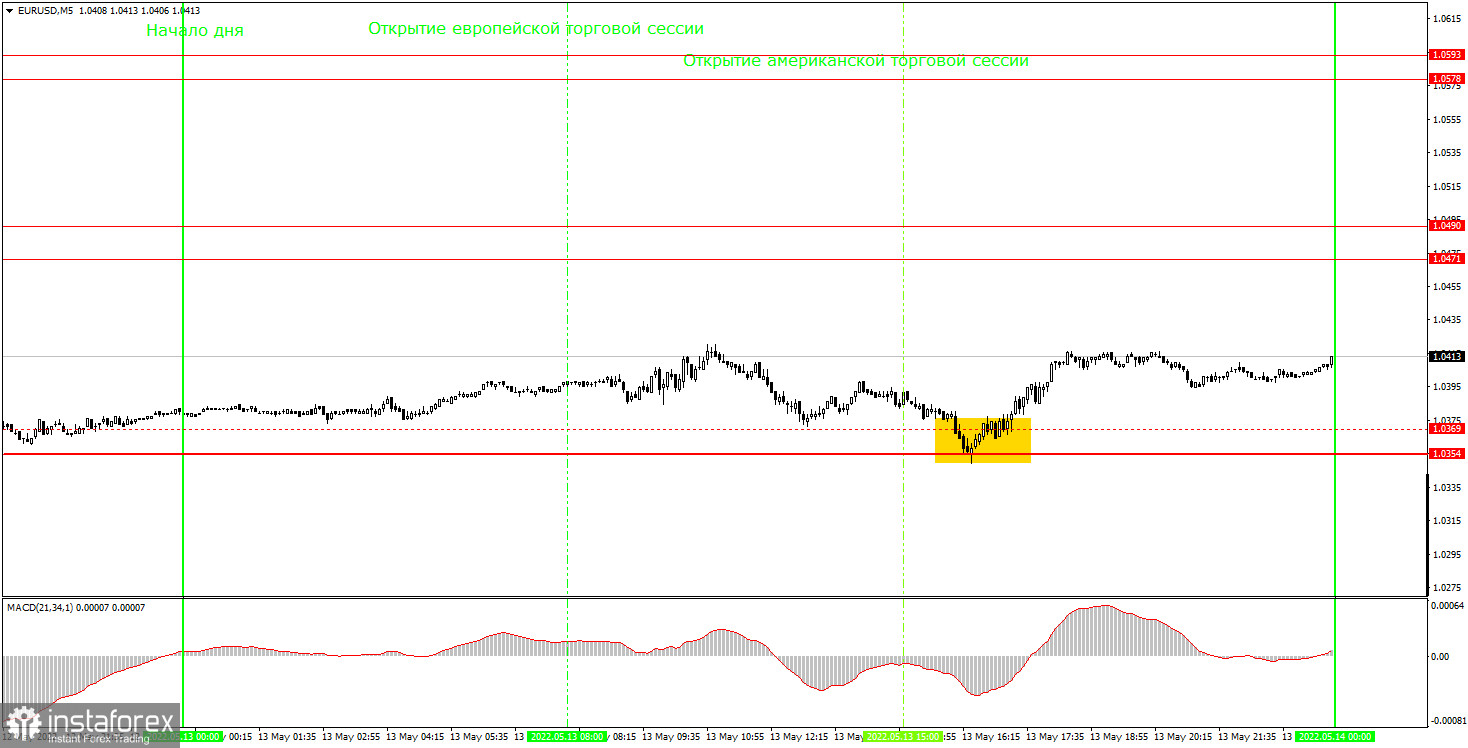Analysis of previous deals:
30M chart of the EUR/USD pair

The EUR/USD currency pair tried to continue its downward movement on Friday, but failed to break through the level of 1.0354. Thus, most of the day there was, if not a flat, then almost a sideways movement. In fact, this moment should not mislead novice traders. The downward trend still continues. Just a couple of days ago, the pair was still inside the two-week horizontal channel, but even in that case, the downward trend remained. And this despite the fact that neither the trend line nor the downward channel on the 30-minute TF has been there for a long time. The trend is clearly visible on the 4-hour timeframe and higher. The European currency continues to be near its 20-year lows, and its stubborn unwillingness to start an upward correction says so far only one thing: it will continue to fall. Now in order for it to continue it should surpass the level of 1.0354. There were no important events in the European Union and the United States on Friday. Formally, traders worked out both the EU industrial production report and the US consumer sentiment index. After the first (disappointing) report, the euro fell in price by 30 points, and after the second (disappointing) report, it fell in price by 30 US dollars. The reaction, therefore, was weak, and the overall picture of the situation did not change.
5M chart of the EUR/USD pair

The technical picture on the 5-minute timeframe is still very simple. There are still few levels near which signals can be formed, so there are also few trading signals. Only one was formed on Friday - near the level of 1.0369, which by the end of the day transformed into the level of 1.0354 (Thursday's low). A rebound from this level is a signal for long positions, after which the price went up no more than 20 points. This was enough to at least set Stop Loss to breakeven. Therefore, the transaction was absolutely not unprofitable. It had to be closed manually in the late afternoon, so you could even make a profit of about 20 points. In general, volatility was rather weak, especially against the backdrop of movements in recent weeks and months. The pair continues to be "at the bottom" and so far, even on a 5-minute timeframe, it is not visible that it is trying to start forming at least a local upward trend.
How to trade on Monday:
The trend remains downward on the 30-minute timeframe, and the price has left the horizontal channel. Despite the fact that the two attempts to surpass the level of 1.0354 had failed, the euro may resume to fall almost at any moment. The market stubbornly refuses to correct the pair, and the foundation and macroeconomics cannot currently support the euro. On the 5-minute TF tomorrow it is recommended to trade at the levels of 1.0354, 1.0471-1.0490, 1.0578-1.0593. When passing 15 points in the right direction, you should set Stop Loss to breakeven. No important event or report scheduled for the European Union or the United States on Monday. However, this does not mean at all that the pair will stand in one place all day. Nevertheless, in recent weeks, volatility is quite high, and the trend is stable. With such input data, traders do not always need grounds for active operations in the foreign exchange market. Moreover, now everyone is guided by the rule "buy a dollar and you will be happy."
Basic rules of the trading system:
1) The signal strength is calculated by the time it took to form the signal (bounce or overcome the level). The less time it took, the stronger the signal.
2) If two or more deals were opened near a certain level based on false signals (which did not trigger Take Profit or the nearest target level), then all subsequent signals from this level should be ignored.
3) In a flat, any pair can form a lot of false signals or not form them at all. But in any case, at the first signs of a flat, it is better to stop trading.
4) Trade deals are opened in the time period between the beginning of the European session and until the middle of the American one, when all deals must be closed manually.
5) On the 30-minute TF, using signals from the MACD indicator, you can trade only if there is good volatility and a trend, which is confirmed by a trend line or a trend channel.
6) If two levels are located too close to each other (from 5 to 15 points), then they should be considered as an area of support or resistance.
On the chart:
Support and Resistance Levels are the Levels that serve as targets when buying or selling the pair. You can place Take Profit near these levels.
Red lines are the channels or trend lines that display the current trend and show in which direction it is better to trade now.
The MACD indicator (14,22,3) consists of a histogram and a signal line. When they cross, this is a signal to enter the market. It is recommended to use this indicator in combination with trend lines (channels and trend lines).
Important speeches and reports (always contained in the news calendar) can greatly influence the movement of a currency pair. Therefore, during their exit, it is recommended to trade as carefully as possible or exit the market in order to avoid a sharp price reversal against the previous movement.
Beginners on Forex should remember that not every single trade has to be profitable. The development of a clear strategy and money management are the key to success in trading over a long period of time.
 English
English 
 Русский
Русский Bahasa Indonesia
Bahasa Indonesia Bahasa Malay
Bahasa Malay ไทย
ไทย Español
Español Deutsch
Deutsch Български
Български Français
Français Tiếng Việt
Tiếng Việt 中文
中文 বাংলা
বাংলা हिन्दी
हिन्दी Čeština
Čeština Українська
Українська Română
Română

